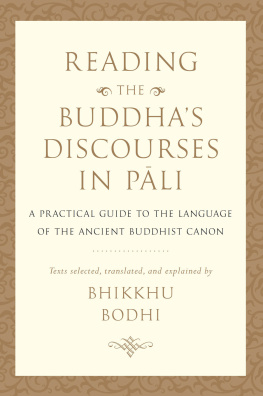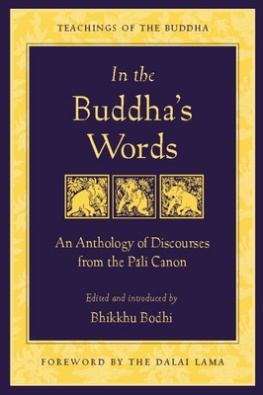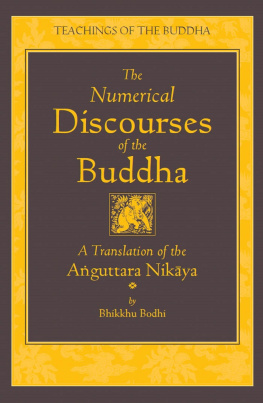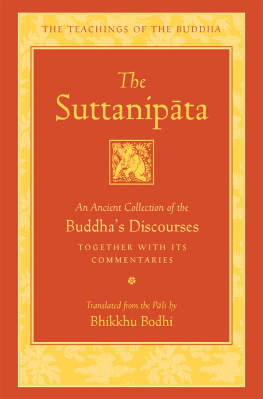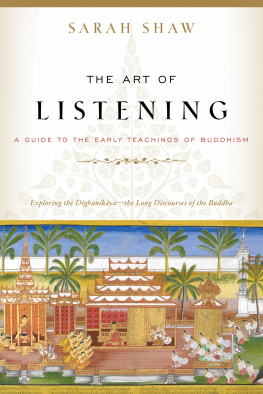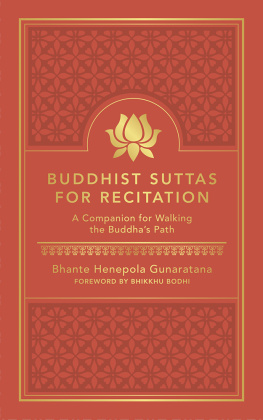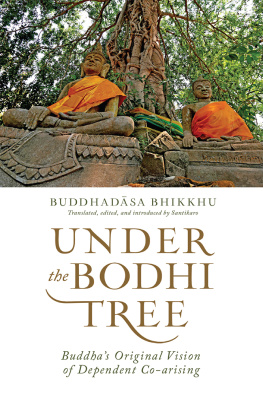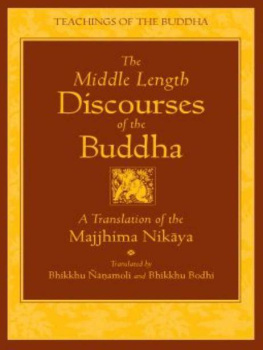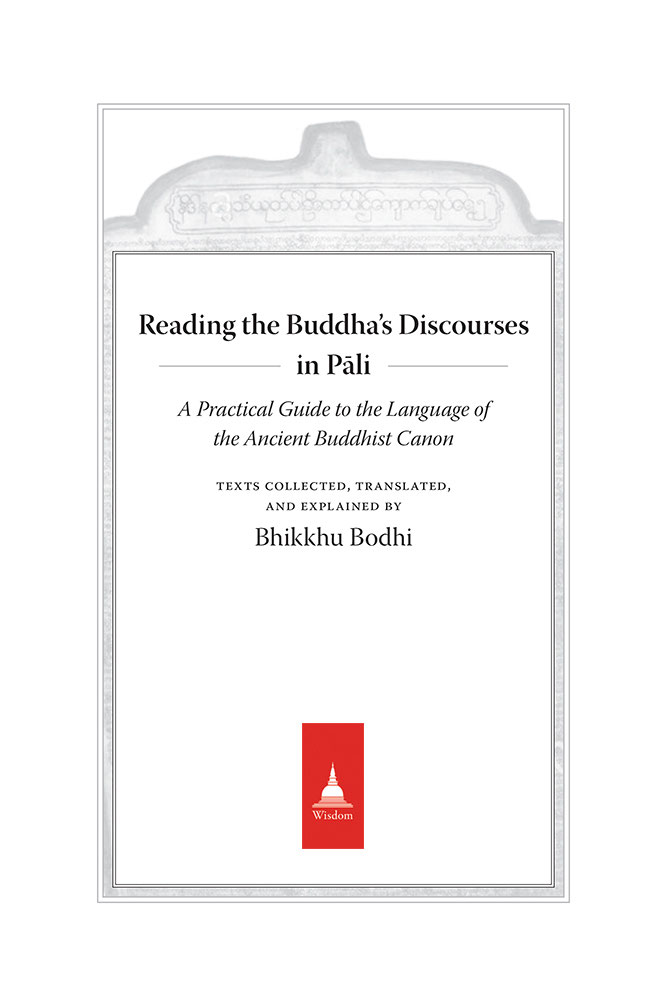Publishers Acknowledgment
The publisher gratefully acknowledges the generous help of the Hershey Family Foundation in sponsoring the production of this book.
Written with characteristic warmth by Bhikkhu Bodhi, one of the foremost translators of Pli literature, Reading the Buddhas Discourses in Pli serves as a wonderfully accessible and much-needed resource both for students of Pli and those who want to deepen their understanding of early Buddhist literature. This generous book offers anyone and everyone the opportunity to come and see for themselves the beautiful world of Pli texts.
ALASTAIR GORNALL, author of Rewriting Buddhism: Pali Literature and Monastic Reform in Sri Lanka, 11571270
Bhikkhu Bodhis overview of Pli grammar, his judicious selection of passages, his literal translations to accompany the final translations, and his clear word-by-word grammatical analysis all add up to a wonderful aid for all who wish to deepen their understanding of the discourses of the Pli canon by reading them directly in Pli.
RUPERT GETHIN, author of Sayings of the Buddha: New Translations from the Pali Nikayas
This is an excellent introduction to the Buddhas teachings and the linguistic medium that the Buddha used to express the timeless truths of the Buddhadhamma. Pli is the closest witness we have to the language the Buddha spoke it preserves the oral, vernacular character and the natural idioms and sonic immediacy of the Teachers dialogues with his contemporaries and teachings to his disciples. Reading the Buddhas Discourses in Pli allows the reader to enter into the thought world of the Buddha, the special linguistic realm that, in its conciseness, immediacy, fluidity, and inner harmony, captures and complements the brilliance of his teachings.
After a near lifetime of Pli-English translation work, Ven. Bodhi has perfected the art. His renderings are always reliable and doctrinally accurate, honoring what the Buddha said and the sincerity, directness, and compassion with which he spoke. Bhikkhu Bodhi does an excellent job in bringing the reader back to the Buddhas time (late fifth to early fourth century BCE) and reanimating his words for a modern reader.
BRYAN LEVMAN, author of Pli, the Language: The Medium and Message
Contents
Preface
THE INTENTION BEHIND the present book is to help students of Early Buddhism learn to read the texts of the Pli Canon in the ancient Indian language in which they have been preserved, the language known as Pli. The book is based on a weekly course in Pli that I have been conducting over the past several years at Chuang Yen Monastery in upstate New York. The course is meant for students who have completed the earlier courses I gave on the basics of Pli grammar and the reading of the Buddhas discourses in Pli, the former based on Lily de Silvas Pli Primer, the latter on James Gair and W. S. Karunatillakes A New Course in Reading Pli. In the subsequent weekly course that I developed we read and analyzed suttas from the major chapters of the Sayutta Nikya. In each class I took a sutta (or portion of a longer sutta), explained the meaning of each word and the grammatical forms involved, and then gave a literal translation of each sentence, followed by a more natural English rendering.
Since most of the students were already familiar with Pli grammar, I sometimes tested their knowledge by asking them to explain the grammatical forms to the other students. Some of the students had not studied Pli grammar and had no desire to learn it, but participated because they wanted to become familiar with the terminology of the texts and to see how translations are constructed on the basis of the original Pli. More than half the students participated online; several even joined from Germany. All the classes were recorded, and each week I made the recordings available to the students in the class as well as to others who would have liked to join but could not attend when the class was in progress.
It occurred to me that the material I compiled during this course would make a suitable textbook for people who want to learn to read the suttas in the original language. Thus, as an experiment, I began taking a selection of the suttas that I taught, breaking them into short units of Pli text, and writing down literal word-for-word (or phrase-by-phrase) translations, followed by more natural translations. As I proceeded, and tested the material with several friends, it became clear that such a book would serve the purpose I envisaged.
The present book, the result of that procedure, is intended for both types of students who participated in my weekly Pli class: those who have already learned the basics of Pli grammar and, having become acquainted with the style and terminology of the suttas, now want to progress further in their reading, and those who do not wish to study Pli grammar but would like to gain as intimate an acquaintance with the language and idiom of the texts as is possible without studying the language grammatically.
One thing that this book is not intended to be is a Pli primer. While I offer a brief overview of Pli grammar and syntax, I do not provide detailed lessons in Pli grammar in its own right. I presuppose that the reader is either already familiar with the basics of the grammar and will understand the explanations given or is not interested in the grammar as such. Those who want to learn Pli grammar should turn to the books I used in the earlier two courses.
Nevertheless, to aid students in deciphering the grammar of the texts, I have added after each reading selection a section of grammatical explanations. These are not intended to cover every minute grammatical structure found in the text under consideration but to clarify points and principles that call for elucidation. As I progress from chapter to chapter, the grammatical explanations gradually diminish. They are intended to be progessive, the later ones building on earlier ones, and I assume that a diligent student who has become familiar with the grammatical structures and patterns explained in the earlier passages will know enough to understand what is taking place grammatically in the later passages. To avoid ambiguities, however, I occasionally repeat explanations that have come earlier and may even have gone to excess in explaining forms found in later passages that were already covered. Sometimes, however, it is better to say too much than too little.
To provide students with access to more ample explanations of the grammar, I have occasionally added references to two comprehensive Pli grammars that I have relied on for clarification. One, available online, is Charles Duroiselles A Practical Grammar of the Pli Language, originally published in Rangoon in 1906. My references to this grammar, however, cite the section numbers of the online edition rather than those in the printed edition of 1906. The other is Vito Perniolas Pali Grammar. Both grammars cover essentially the same territory, though occasionally one will treat a topic in more detail or in a more satisfactory way than the other. I have also on occasion referred to Steven Collinss A Pali Grammar for Students, Wilhelm Geigers A Pli Grammar, especially on phonology, A. K. Warders Introduction to Pali, and William Dwight Whitneys Sanskrit Grammar. Since Sanskrit and Pli are closely related, principles that govern Sanskrit grammar are often applicable to Pli as well.

